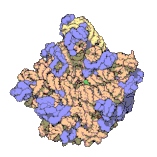
Back بروتين الريبوسوم Arabic Ribosomski protein BS Proteína ribosómica Spanish Protéine ribosomique French Ribosomaal eiwit Dutch Białka rybosomalne Polish Рибосомні білки Ukrainian Protein ribosome Vietnamese 核糖体蛋白质 Chinese
A ribosomal protein (r-protein or rProtein[1][2][3]) is any of the proteins that, in conjunction with rRNA, make up the ribosomal subunits involved in the cellular process of translation. E. coli, other bacteria and Archaea have a 30S small subunit and a 50S large subunit, whereas humans and yeasts have a 40S small subunit and a 60S large subunit.[4] Equivalent subunits are frequently numbered differently between bacteria, Archaea, yeasts and humans.[5]
A large part of the knowledge about these organic molecules has come from the study of E. coli ribosomes. All ribosomal proteins have been isolated and many specific antibodies have been produced. These, together with electronic microscopy and the use of certain reactives, have allowed for the determination of the topography of the proteins in the ribosome. More recently, a near-complete (near)atomic picture of the ribosomal proteins is emerging from the latest high-resolution cryo-EM data (including PDB: 5AFI).
- ^ Salini Konikkat: Dynamic Remodeling Events Drive the Removal of the ITS2 Spacer Sequence During Assembly of 60S Ribosomal Subunits in S. cerevisiae. Carnegie Mellon University Dissertations, Feb. 2016.
- ^ Weiler EW, Nover L (2008). Allgemeine und molekulare Botanik (in German). Stuttgart: Georg Thieme Verlag. p. 532. ISBN 978-3-13-152791-2.
- ^ de la Cruz J, Karbstein K, Woolford JL (2015). "Functions of ribosomal proteins in assembly of eukaryotic ribosomes in vivo". Annual Review of Biochemistry (in German). 84: 93–129. doi:10.1146/annurev-biochem-060614-033917. PMC 4772166. PMID 25706898.
- ^ Rodnina MV, Wintermeyer W (April 2011). "The ribosome as a molecular machine: the mechanism of tRNA-mRNA movement in translocation". Biochemical Society Transactions. 39 (2): 658–62. doi:10.1042/BST0390658. PMID 21428957.
- ^ Ban N, Beckmann R, Cate JH, Dinman JD, Dragon F, Ellis SR, et al. (February 2014). "A new system for naming ribosomal proteins". Current Opinion in Structural Biology. 24: 165–9. doi:10.1016/j.sbi.2014.01.002. PMC 4358319. PMID 24524803.

